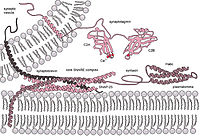
Photo from wikipedia
Fast and temporally controlled release is imperative for neurotransmitter release via evoked synaptic vesicle exocytosis. This process is driven by the interaction between vesicle v-SNAREs with target t-SNAREs on the… Click to show full abstract
Fast and temporally controlled release is imperative for neurotransmitter release via evoked synaptic vesicle exocytosis. This process is driven by the interaction between vesicle v-SNAREs with target t-SNAREs on the plasma membrane. The initial, nanometer-sized connection between two fusing lipid bilayers is called the fusion pore. This structure only lasts for a short time before it either dilates completely (resulting in full fusion), or reseals again (kiss-and-run fusion). Fusion pore dynamics determine the amount and size of cargo released, as well as vesicle recycling. Thus they constitute a fundamental mechanism that controls the extent of postsynaptic neuronal activity. Due to its small size and transient nature, the fusion pore has been an elusive object to study. We have recently developed an assay using biochemically well-defined components to look at current flow through single SNARE-mediated fusion pores. The components of the assay include HeLa cells with “flipped” t-SNARE proteins expressed on the outside of the cell (t-cells), and nanodiscs with v-SNARE proteins embedded within them (v-discs). When we fill a patch pipette with v-discs and establish a cell-attached patch onto a t-cell, the v- and t-SNAREs interact, leading to the formation of a fusion pore connecting the cytosol to the pipette solution. Currents through these fusion pores report single fusion pore dynamics.Membrane tension has been shown to affect fusion pore dynamics in neuroendocrine cells. In our assay, we can quickly and accurately change the pressure in the patch pipette, thereby modulate membrane tension, using a high-speed pressure clamp. We will show how an increase in membrane tension causes extended pore lifetimes, as well as increased pore conductance and charge influx through the pore.
Journal Title: Biophysical Journal
Year Published: 2017
Link to full text (if available)
Share on Social Media: Sign Up to like & get
recommendations!